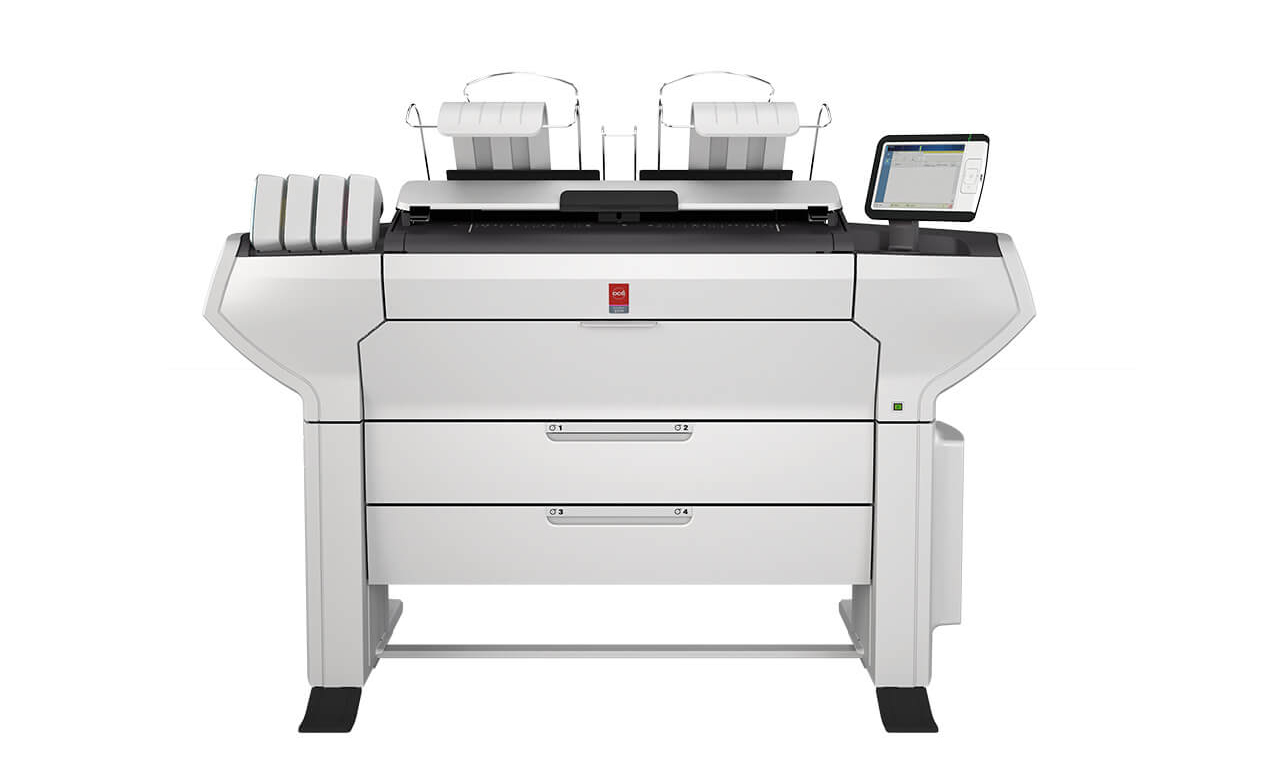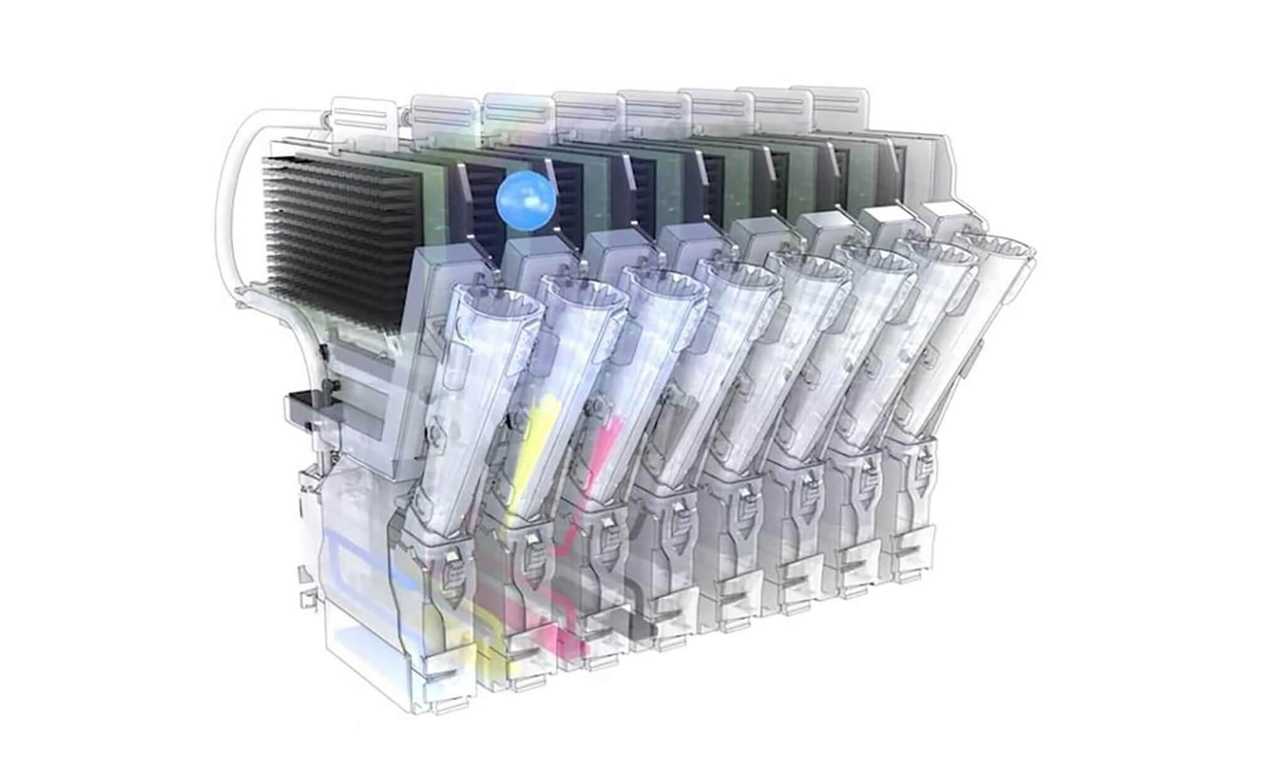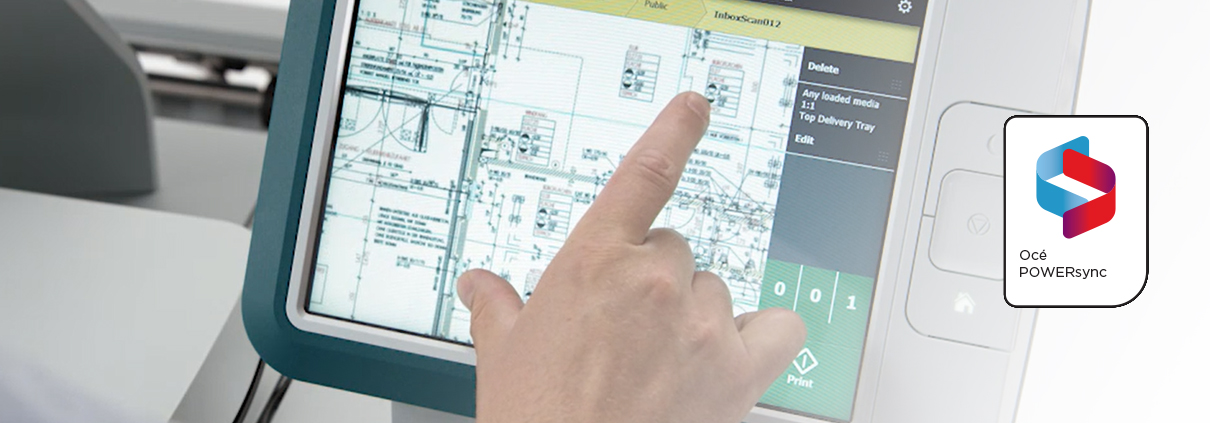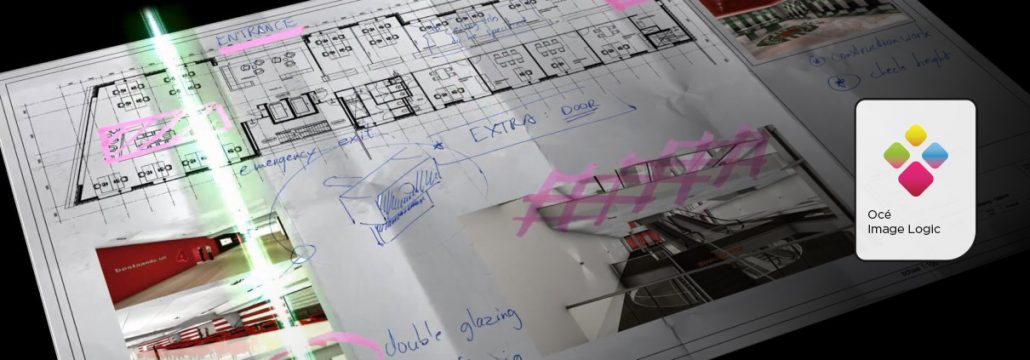New Océ ColorWave series models - enhanced printing technology
The end of 2018 was marked by the release of two new models of the Océ ColorWave 3000 series, which replaced the Océ ColorWave 500 and ColorWave 700. In addition to the improved features of their predecessors, the CW3500 and CW3700 received a number of new functions.
Until 2016, Canon / Océ had a leading market position in the low and medium volume segment of color and black and white printing for CAD / GIS. The share of our equipment exceeded 70%, and in 2014 even amounted to 83%. However, in 2016, the picture began to change, and in order to maintain leadership, the company released a new model range of the Océ ColorWave 3000 series.

The CW3500 and CW3700 use Océ CrystalPoin t technology, which combines the features and benefits of laser and inkjet printing. Laser printing eliminates ink spreading, gives instant drying and water resistance of images, but is a source of ozone, high energy consumption, toner dust, material deformation due to heating in the fixing system. Accidental spilling of toner can not only spoil the prints, but also harm the health of the user. Inkjet printing has flexible settings and precision droplet positioning. However, depending on the ink and media used, the image may be blurred or colors and contrast may be lost. In addition, when using solvent inks and water-based inks, the imprint needs to be further dried with evaporating moisture.
Océ CrystalPoint technology is based on the use of Océ TonerPearls toner, which is a round bead. In fact, this ink, which under normal conditions are in a solid state. They do not create dust and are not toxic. Granules are supplied in transparent cartridges. Due to this, the user can always visually determine the amount of remaining toner. Replacing the cartridge is performed even during printing. To do this, do not interrupt the process, as it happens, for example, when replacing the cartridge during laser printing.
')
Océ TonerPearls toner cartridges are installed on top of the printer. Under the action of gravity, the granules roll down into the print head. A heating element located in the printhead warms the toner to a liquid state. When printing, drops of gel are ejected from the nozzles and instantly crystallize on the surface of the carrier. Therefore, prints are immediately ready for use and can be applied to a wide range of media. For printing can be used as high-quality paper and recycled paper and various films without loss of image quality, which significantly reduces the cost of the process.

Due to the “omnivorous nature” of the equipment in terms of media and the high performance characteristics of Océ TonerPearls ink, the scope of the CW3500 and CW3700 can go far beyond color and black-and-white printing for CAD / GIS. If, in addition to drawings and maps, you can also print backlit and street design products on the Océ ColorWave 3500, the Océ ColorWave 3700 can do artistic print, floor graphics, banners and soft signs.
The broad capabilities of the CW 3700 are explained by the use of MediaSense technology. In inkjet printing, image quality is largely dependent on the distance from the print head to the media. If the distance is greater than the optimum, then it will be difficult to ensure accurate positioning of the drop, and if less, then the drop will not have time to form and the probability of carrier jam significantly increases. Therefore, the vast majority of printing equipment has a limited range of media used. Usually, the calculations take the average thickness of the most common carriers for tasks for which the equipment is designed. A small tolerance of the carrier thickness in one direction or another significantly narrows the choice of carriers, even without taking into account the characteristics of the carrier itself. So the model ColorWave 3500 prints on media with a thickness of up to 0.4 mm. The ColorWave 3700 model uses MediaSense technology, which consists in automatic three-step configuration:
As a result, the CW 3700 can handle media up to 0.8 mm thick. The new ColorWave 3000 series also uses Océ PAINT (Piezo Acoustic Integrated Nozzle technology) technology. It consists in piezo-acoustic control and cleaning nozzles. The printer constantly monitors the signals from the piezoelectric elements of the printhead for compliance with normal operation. The change in the signal indicates the incorrect operation of the corresponding nozzle. In this case, the original algorithm for compensating for gaps from a non-working nozzle is activated. After cleaning the ink supply in all nozzles returns to the regular mode. Maintenance of the print head occurs automatically without operator intervention.
The ColorWave 3000 series uses the Océ POWERsync controller. The architecture of the Océ POWERsync controller (Multi Memory Architecture) is designed to ensure maximum performance by simultaneously performing various tasks. There are enough computing resources to perform scanning with simultaneous operation of the RIP (Raster Image Processor). At receipt of several tasks for the press their multi-threaded processing is organized. For example, after accepting the first task, reception of the second one begins, while the first one is sent to the buffer and queued. Then the third task is received, the second is sent to the spool, and the first is processed by the raster processor (RIP) and transferred to the internal print file. That is, all workflows proceed in a series-parallel mode. This is much faster than if all tasks were performed only sequentially.
The Océ POWERsync controller also has a multi-threaded memory architecture based on dual hard drives (Dual Memory Architecture). Usually, in addition to RAM, a paging file is allocated on the hard disk, which serves as virtual RAM. However, the speed of data exchange with virtual RAM is much lower than with physical RAM. Because of this, many processes can seriously slow down. The ColorWave 3000 series uses high capacity physical RAM (8 GB) and two hard drives. Because of this, the printer only communicates with the RAM, and the RAM with the hard drives, which are separated processes. For example, input / output of data spooling on one hard disk, and scanning and printing on another. At the same time, the controller's performance does not decrease even during periods of peak loads.

Unlike the previous ColorWave 500/700 series, where the Océ POWERsync controller was based on Windows 8 Embedded, in the new ColorWave 3000 models the controller runs on the basis of Microsoft Windows 10 IoT Enterprise. This is a guarantee that it will be possible to receive updates from Microsoft for much longer than for Windows 8 (Microsoft plans to support Windows 10 at least until 2026).
Instead of the former PDF Configurable PostScript Interpreter (CPSI) interpreter in the new models, the Adobe PDF Print Engine (APPE) is integrated into the POWERsync controller. This solution works well with transparency effects in files, has a high processing speed, which is especially convenient when working with large PDF files, and is perfectly compatible with Acrobat Reader.
For devices of the ColorWave 3000 series, the package bundle is provided with an integrated scanner. Especially for these versions comes Océ Image Logic's patented technology. It is designed to produce high-quality copies even from low quality originals. Those who often encounter copying know that it is sometimes quite difficult to get a high-quality copy. New technology Océ Image Logic in addition to scanning, performs subsequent image processing. The process takes place in four stages:

Together with our equipment we deliver a free software package.
It consists of:
Océ Publisher Select 3
The application can manage the work of two printers at the same time and supports all new CAD printing languages, including HP / GL, HP / GL2, TIFF, JPEG, CALCOMP, CALS, C4 and NIRS. An additional convenient feature was the ability to switch between printers and disconnect from them without having to close the application. Océ Publisher Select 3 also has the following advantages:
Océ WPD2
This driver allows users to efficiently print from Windows applications on Océ wide format printers. Océ WPD2 has the following features:
Océ Publisher Mobile
This useful application allows you to print documents on Océ plotters, controlling them from a tablet or smartphone running iOS or Android. In fact, this is a serious and convenient offer for mobile printing. With Océ Publisher Mobile, you can:
The application works with all Océ TDS, TCS, PlotWave and ColorWave printers.
The ColorWave 3500 and ColorWave 3700 models have many more useful options that increase usability and reduce the cost of prints. And the ability to work with a wide range of carriers gives the service provider a significant expansion of the range.
We will be glad to provide more detailed information about our equipment to interested persons upon request.
Until 2016, Canon / Océ had a leading market position in the low and medium volume segment of color and black and white printing for CAD / GIS. The share of our equipment exceeded 70%, and in 2014 even amounted to 83%. However, in 2016, the picture began to change, and in order to maintain leadership, the company released a new model range of the Océ ColorWave 3000 series.

The CW3500 and CW3700 use Océ CrystalPoin t technology, which combines the features and benefits of laser and inkjet printing. Laser printing eliminates ink spreading, gives instant drying and water resistance of images, but is a source of ozone, high energy consumption, toner dust, material deformation due to heating in the fixing system. Accidental spilling of toner can not only spoil the prints, but also harm the health of the user. Inkjet printing has flexible settings and precision droplet positioning. However, depending on the ink and media used, the image may be blurred or colors and contrast may be lost. In addition, when using solvent inks and water-based inks, the imprint needs to be further dried with evaporating moisture.
Océ CrystalPoint technology is based on the use of Océ TonerPearls toner, which is a round bead. In fact, this ink, which under normal conditions are in a solid state. They do not create dust and are not toxic. Granules are supplied in transparent cartridges. Due to this, the user can always visually determine the amount of remaining toner. Replacing the cartridge is performed even during printing. To do this, do not interrupt the process, as it happens, for example, when replacing the cartridge during laser printing.
')
Océ TonerPearls toner cartridges are installed on top of the printer. Under the action of gravity, the granules roll down into the print head. A heating element located in the printhead warms the toner to a liquid state. When printing, drops of gel are ejected from the nozzles and instantly crystallize on the surface of the carrier. Therefore, prints are immediately ready for use and can be applied to a wide range of media. For printing can be used as high-quality paper and recycled paper and various films without loss of image quality, which significantly reduces the cost of the process.

Due to the “omnivorous nature” of the equipment in terms of media and the high performance characteristics of Océ TonerPearls ink, the scope of the CW3500 and CW3700 can go far beyond color and black-and-white printing for CAD / GIS. If, in addition to drawings and maps, you can also print backlit and street design products on the Océ ColorWave 3500, the Océ ColorWave 3700 can do artistic print, floor graphics, banners and soft signs.
The broad capabilities of the CW 3700 are explained by the use of MediaSense technology. In inkjet printing, image quality is largely dependent on the distance from the print head to the media. If the distance is greater than the optimum, then it will be difficult to ensure accurate positioning of the drop, and if less, then the drop will not have time to form and the probability of carrier jam significantly increases. Therefore, the vast majority of printing equipment has a limited range of media used. Usually, the calculations take the average thickness of the most common carriers for tasks for which the equipment is designed. A small tolerance of the carrier thickness in one direction or another significantly narrows the choice of carriers, even without taking into account the characteristics of the carrier itself. So the model ColorWave 3500 prints on media with a thickness of up to 0.4 mm. The ColorWave 3700 model uses MediaSense technology, which consists in automatic three-step configuration:
- when the media is fed, the printer measures its thickness
- determines the best distance between the media and the print head
- sets the optimal feed rate for the media, based on its characteristics.
As a result, the CW 3700 can handle media up to 0.8 mm thick. The new ColorWave 3000 series also uses Océ PAINT (Piezo Acoustic Integrated Nozzle technology) technology. It consists in piezo-acoustic control and cleaning nozzles. The printer constantly monitors the signals from the piezoelectric elements of the printhead for compliance with normal operation. The change in the signal indicates the incorrect operation of the corresponding nozzle. In this case, the original algorithm for compensating for gaps from a non-working nozzle is activated. After cleaning the ink supply in all nozzles returns to the regular mode. Maintenance of the print head occurs automatically without operator intervention.
The ColorWave 3000 series uses the Océ POWERsync controller. The architecture of the Océ POWERsync controller (Multi Memory Architecture) is designed to ensure maximum performance by simultaneously performing various tasks. There are enough computing resources to perform scanning with simultaneous operation of the RIP (Raster Image Processor). At receipt of several tasks for the press their multi-threaded processing is organized. For example, after accepting the first task, reception of the second one begins, while the first one is sent to the buffer and queued. Then the third task is received, the second is sent to the spool, and the first is processed by the raster processor (RIP) and transferred to the internal print file. That is, all workflows proceed in a series-parallel mode. This is much faster than if all tasks were performed only sequentially.
The Océ POWERsync controller also has a multi-threaded memory architecture based on dual hard drives (Dual Memory Architecture). Usually, in addition to RAM, a paging file is allocated on the hard disk, which serves as virtual RAM. However, the speed of data exchange with virtual RAM is much lower than with physical RAM. Because of this, many processes can seriously slow down. The ColorWave 3000 series uses high capacity physical RAM (8 GB) and two hard drives. Because of this, the printer only communicates with the RAM, and the RAM with the hard drives, which are separated processes. For example, input / output of data spooling on one hard disk, and scanning and printing on another. At the same time, the controller's performance does not decrease even during periods of peak loads.

Unlike the previous ColorWave 500/700 series, where the Océ POWERsync controller was based on Windows 8 Embedded, in the new ColorWave 3000 models the controller runs on the basis of Microsoft Windows 10 IoT Enterprise. This is a guarantee that it will be possible to receive updates from Microsoft for much longer than for Windows 8 (Microsoft plans to support Windows 10 at least until 2026).
Instead of the former PDF Configurable PostScript Interpreter (CPSI) interpreter in the new models, the Adobe PDF Print Engine (APPE) is integrated into the POWERsync controller. This solution works well with transparency effects in files, has a high processing speed, which is especially convenient when working with large PDF files, and is perfectly compatible with Acrobat Reader.
For devices of the ColorWave 3000 series, the package bundle is provided with an integrated scanner. Especially for these versions comes Océ Image Logic's patented technology. It is designed to produce high-quality copies even from low quality originals. Those who often encounter copying know that it is sometimes quite difficult to get a high-quality copy. New technology Océ Image Logic in addition to scanning, performs subsequent image processing. The process takes place in four stages:
- Scan the original. When scanning the original document, each line of the image is converted to a scale of shades from 0 to 255. This creates an image containing 256 shades of gray.
- Customize the background. The background of the document is eliminated by increasing the pixel values, taking into account the detected level of this background. Then for all levels of the background of one page the same gray level is set, which as a result allows to get an image without a background.
- Image enhancement . Imperfect details are enhanced by digital processing, through specially designed filtering. For example, in the filtering process, thin pencil lines are amplified, and shaded areas are smoothed.
- Processing tones. The halftone image is converted to black and white due to the “Error Diffusion” error smoothing technique. Each pixel of the document is processed, as a result of which weak lines, solid colors and text are clearly defined and filled. Then the image is finally processed - and ready for further use.

Together with our equipment we deliver a free software package.
It consists of:
- Océ Publisher Select 3
- Océ WPD2
- Océ Publisher Mobile
Océ Publisher Select 3
The application can manage the work of two printers at the same time and supports all new CAD printing languages, including HP / GL, HP / GL2, TIFF, JPEG, CALCOMP, CALS, C4 and NIRS. An additional convenient feature was the ability to switch between printers and disconnect from them without having to close the application. Océ Publisher Select 3 also has the following advantages:
- Enhance workflow productivity with two printers: for any combination of wide format devices that support Océ PlotWave, Océ ColorWave and Canon imagePROGRAF;
- Saves operator time and effort by automatically detecting connected printers, quickly switching between printers, monitoring current toner / ink status, and improved job “drag and drop”;
- Standardization of workflow by assigning specialized media templates to print jobs or individual files in print jobs that contain several files, or the simultaneous assignment of several hot folders;
- Prevent rejects of print due to proper printing the first time with automatic preprocessing, instant previews in WYSIWYG mode (“what you see, you get”) and printing by pressing the “green button”.
Océ WPD2
This driver allows users to efficiently print from Windows applications on Océ wide format printers. Océ WPD2 has the following features:
- automatic operation with default settings and custom settings templates;
- Constant information about the status of the printer, media and the presence of ink;
- Easy installation using Océ Connect Assistant and auto-discovery of printers
- easy deployment of configurations with templates and shared custom sizes;
- Optimal data processing for fast application availability to speed return to work
- clear and modern user interface in which all functions are available on the main screen.
Océ Publisher Mobile
This useful application allows you to print documents on Océ plotters, controlling them from a tablet or smartphone running iOS or Android. In fact, this is a serious and convenient offer for mobile printing. With Océ Publisher Mobile, you can:
- get access to the main settings
- view custom log,
- check the status of the media and ink,
- perform scaling,
- preview the printed documents in PDF, JPG and TIFF formats (To preview the DWF file, you need to use a special application).
The application works with all Océ TDS, TCS, PlotWave and ColorWave printers.
The ColorWave 3500 and ColorWave 3700 models have many more useful options that increase usability and reduce the cost of prints. And the ability to work with a wide range of carriers gives the service provider a significant expansion of the range.
We will be glad to provide more detailed information about our equipment to interested persons upon request.
Source: https://habr.com/ru/post/432432/
All Articles